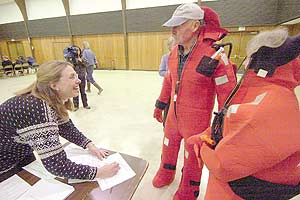|
http://www.theworldlink.com/articles/2006/11/30/news/news01113006.txt
Opinions vary on
Klamath dam removal
By Susan
Chambers, TheWorldLink.Com
November
30, 2006

|
|
World Photos by Lou Sennick
Before the start of the
Federal Energy Regulatory
Commission town hall meeting
Wednesday in North Bend,
Marcelle Lynde, left, takes
the names of Daryl and Sally
Bogardus. The Charleston
couple were wearing survival
suits to quietly make a point
that the fishing industry is
in need of emergency help.
|
A handful of
commercial salmon trollers dressed
in bright orange survival suits
provided color to a meeting that
dealt with issues that are
anything but black and white.
At the request of Rep. Peter
DeFazio, D-Ore., the Federal
Energy Regulatory Commission held
an additional hearing Wednesday on
the relicensing of four Klamath
River dams in North Bend. Four
other FERC meetings already were
held in Klamath Falls, and Yreka
and Eureka, Calif., and another
meeting will be held in Newport
tonight.
DeFazio requested the coastal
hearing so that fishermen and
coastal communities, constituents
affected by a downturn of Klamath
River fall Chinook populations,
could comment on the draft
environmental impact statement
that could affect their futures.
DeFazio planned to attend but was
ill.
But he still
had a voice at the hearing.
DeFazio aide Ron Kreskey was the
first speaker, reading a statement
from the congressman into the
record.
“I would strongly urge FERC to
reconsider and instead, at a
minimum, to condition relicensing
on the fishways recommended by the
resource agencies. ... Further, I
believe it makes sense to
condition the license on
outcomes-based research on the
health of salmon populations. ...
Granting a 50-year license only to
find out in 10 or 20 years that
the prescriptions proposed by the
agencies, or alternatives proposed
by Pacificorp, fail to protect
salmon would condemn fishing
families and the businesses and
communities that rely on them to
financial ruin,” his statement
said.
Most of DeFazio's comments dealt
with fish passage around the dams,
for which various options were
addressed in the environmental
review. One option proposed by
PacificCorp and supported by FERC
staff, would involve trucking
salmon around the dams. The
National Marine Fisheries Service
and U.S. Fish and Wildlife Service
both concluded that, in the
absence of dam removal, building
fish passageways would be a better
option and allow salmon and
steelhead access to more habitat.
Much of the controversy over
relicensing the Iron Gate, Copco
1, Copco 2 and J.C. Boyles dams
has centered around removal of the
dams. None were put in with fish
passage in mind and some people
believe removing them is the best
option. Others promote the
alternative of simply adding fish
passages to the dams. One of the
analyses in the environmental
study also recommended removal of
two dams.
It's a murky issue and one that
wasn't made clearer Wednesday
night. Representatives of the
fishing industry provided
substantial comments but offered
no consensus on dam removal.
Fisherman and buyer Scott Boley,
of Gold Beach, is for removing the
dams, though he recognizes tearing
them down might not happen right
away and that the energy
generation those dams provide must
be taken into account.
But as far as
restoring the health of the
salmon, “I believe the only
solution is to remove the dams,”
Boley said.
Fisherman Paul Heikkila, who also
supported dam removal, noted that
even with fish passages included
on the dams, fish can suffer with
other problems, such as unstable
water flows and parasites.
New technology could help,
Charleston troller Rayburn Guerin
said.
“As far as the dams go - it's not
in our best interest to remove
them,” he said, noting that new
developments in fish ladders and
other passageways could enable
fish to return to the upper
reaches.
One of the main problems is
population growth, Guerin said.
More people are moving to the
coastal areas. The energy produced
by the dams could be needed in the
next 20 years or so.
But new technology could help.
Tyler Long, from the Reedsport
area, brought up the fact that
harnessing the energy from ocean
waves is looking like a viable
alternative energy source in the
future and could eliminate the
need for the dams.
Some commenters dressed in the
bright orange “gumby” suits,
designed to increase fishermen's
chances of survival if they go
overboard in the ocean,
underscored the necessity of
economic survival.
Troller Jeff Reeves said the
attire was to help draw attention
for the need for federal financial
assistance.
“We need and expect disaster
funding,” Reeves said.
As far as removing the dams, it
likely would take too long and
fishermen need help now - for the
fishing season next year and in
upcoming years, he added.
But regardless of the dam issue,
troller Paul Merz addressed
something much more immediate: the
relicensing itself.
“A 50-year license is ridiculous,”
Merz said. “I have to buy a
license every year.”
FERC's director of the division of
hydropower licensing, Ann Miles,
said the five-member commission
will take the final environmental
impact statement into
consideration and decide to
relicense the dams based on
whether the dam operators do a
little, medium or a lot of
mitigation work.
“Most licenses are closer to the
30- to 40-year range,” Miles said.
Sport angler John Ward, president
of the Southwest chapter of the
Northwest Steelheaders, said
recreational fishermen barely got
a season but watched as commercial
trollers were tied to the dock.
It's not something he wants to see
again.
“It hurts all of us,” Ward said of
the limited seasons.
“You have important, difficult
decisions to make and many factors
to consider,” he said, “but the
biggest factor is the fish.” |

